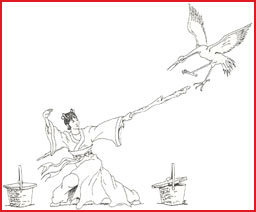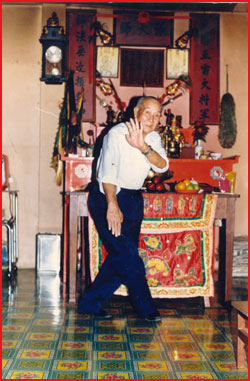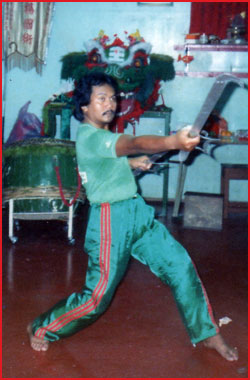
History
of White Crane Kung fu |
| (Before
proceeding further, it is important to explain that there are
actually two martial art systems emanating from China that bear
the name of White Crane: one originates in Tibet and the other
in the southern coastal province of Fukien. Both arts are famous
and have glorious histories of their own. This fact is mentioned
in order to avoid confusing the public. Although rare in the western
world, Fukien White Crane is a famous fighting style in Southeast
Asia. In fact, it is widely considered to be one of the ancestors
of several traditional Okinawan Karate systems). We have presented
below a very detailed account of this artís history as it this
information is not readily available. To learn more about the
Fukien White Crane, itís history and theories, consult Shifu Lorne
Bernardís latest work ďShaolin
White Crane Kung Fu: A rare art revealed
|
|
The
history of the Fukienese White Crane Kung Fu has been passed down from
master to student (father to son) for five generations. Although various
accounts do exist, they all tell a similar tale. The history of White
Crane Kung Fu as passed down within the Lee family is presented below.
|
|
Fang
Chi-Niang was born in Lei Chow Fu in the middle of the 18th
century. Her father's name was Fang Hui Sz and her mother's name was
Lee Pik Liung. Fang Hui Sz studied Kung Fu in the Shaolin temple at
Nine Lotus Mountain, Ching Chiang district, Fukien (modern day Fujian)
province. His wife and daughter lived at Lei Chow Fu. Since they were
victimized by local landlords, it was decided to move away from the
village.
|

Eventually, they settled down in Ching Chu temple, on Ching
Chea Mountain (Lei Chow Fu). One day, as Fang Chi-Niang was drying grain
in front of the temple, she saw a huge crane come down from the roof
and begin to eat. She decided to use a bamboo stick to chase away the
intruder. Fang Chi-Niang was both curious and fearful of the crane.
At first, she tried to strike its head but the bird was evasive. Then
she attempted to hit the crane's wings but it stepped to the side and
used its claw to block the attack. When Fang Chi-Niang tried to poke
the bird's body with her staff, it moved back and used its beak to peck
the bamboo. Fang Chi-Niang was surprised. She continued to use the techniques
her father had taught her but her efforts were completely unsuccessful.
Astonished by the crane's skill, Fang Chi-Niang sought to practice with
it on a daily basis. Fortunately, the crane obliged. This permitted
Fang Chi-Niang to analyze and absorb the bird's self-defense strategies.
Eventually, she mastered the movements and spirit of the crane.
|
|
During
this period, Emperor Chien Lung ordered the destruction of the Southern
Shaolin temple after having been informed of revolutionary activities
on its grounds. Fang Hui-Sz was one of the few fortunate ones to escape
the attack. He sought out his wife and daughter and they initially settled
at Pik Chui Liang. Subsequently, Fang Hui-Sz moved to Sah Liang temple
near Foochow, where he spent his spare time refining his daughter's
Shaolin Kung Fu. Fang Chi-Niang eventually mastered everything her father
could teach her and chose to combine the crane's spirit and movements
with her Shaolin Kung Fu. She taught Kung Fu at Sah Liang temple to
Weng Wing-Seng, Lee Fah-Sieng, Chang The-Cheng, and Ling Te-Sun. Weng
was from Lei Chow Fu, Lee was from Chow Ann district, Chang was from
Wing Chun district, and Ling was from Foochow. Weng and Lee taught many
students at Kao Pei Cliff and set up a school there. Chang (nicknamed
Nine Dots monk) settled at the White Crane temple and taught martial
arts. Ling's descendants moved to Taiwan. Lee passed his skills to his
son Lee Mah-Saw. Lee Mah-Saw continued to set up schools and taught
in Chow Ann district. Fang Chi-Niang's teachings gave birth to different
interpretations and four principal styles were developed: Flying Crane
(Fei He), Eating Crane (Shi He) Screaming Crane (Ming He) and Sleeping
Crane (Jan He or Su He). Later on, variations and combinations with
other systems occurred which led to the creation of even more types
of Fukienese White Crane.
|
|
At
this point, it may be useful to debate whether the Fukienese White Crane
arts are truly Shaolin systems or whether they represent a separate
school. Since they were created outside the temple, many older generation
White Crane masters do not consider their art to be a Shaolin art. This
belief is compounded by the fact that White Crane focuses heavily upon
soft power in the advanced stages. On the other hand, the founder did
study from her father who was an accomplished Southern Shaolin practitioner.
Consequently, it is difficult to resolve the debate as it is largely
a question of perspective. Perhaps it is best to acknowledge the root
of the art while simultaneously recognizing the founder's unique contributions.
|
Grand-Master
Lee Kiang-Ke: Bringing White Crane into the 20th Century |

Historically,
with the end of feudal social systems and the widespread use of firearms,
advanced methods of combat are no longer an every day necessity. This
fact of life, combined with the traditionally secretive nature of kung
fu instruction, is contributing to the loss of an irreplaceable part
of China's cultural heritage. Many of the hundreds of different styles
of kung fu are in danger of being lost or diluted to the point of extinction.
For
practitioners of Fukien-style White Crane Kung Fu, the life of Grandmaster
Lee Kiang-Ke (1903-1992) represents both a link to the past and window
toward the future. To properly understand the reverence a martial artist
has for his or her Grandmaster, it is necessary to view the martial
art in its proper historical and cultural context. One important difference
between the martial arts and other forms of physical activity is that
martial arts can be practiced and enjoyed for a lifetime, and progress
can be made at virtually any age. As such, many older masters are considered
living treasures, due to the decades of accumulated knowledge, experience,
and teaching expertise that they possess. Today, fewer and fewer people
are willing to devote their lives to the study and teaching of martial
arts as was done in the past. Because of this unfortunate reality, priceless
martial knowledge often disappears forever upon the death of an elderly
Grandmaster. This is especially true in the many styles of Chinese martial
arts, where kung fu Shifus were secretive about their personal fighting
art, and unwilling to disseminate it indiscriminately.
Fukien
White Crane Kung Fu is continuing to thrive, thanks to the enlightened
thinking of one of its foremost proponents. Third-generation Grand-Master
Lee Kiang-Ke was the single most influential person responsible for
the preservation and dissemination of the flying crane system of Fukien
White Crane. His choice to open to the public what had previously been
a closed-door system ensured the survival of a most complete and devastating
Chinese martial art system.
|
|
Grandmaster
Lee Kiang-Ke (Lee Kiang-Kay) started to learn Kung Fu from his father
at the age of seven. After 10 years of arduous training, his father
sent him away to live at a temple (Bai He An) where he furthered his
martial knowledge under the instruction of a temple monk known as "Nine-dots
Monk." This temple specialized in the instruction of Fang Chi-Niang's
White Crane techniques. After four years of intensive study, the young
master returned home to assist his father in teaching White Crane and
in practicing herbal medicine. In time, he became the chief instructor
and medical practitioner in his community. Later on, the Kuomintang
(Chinese Nationalist government) invited him to join the 49th
Army Division as a medic. He ended up also teaching the soldiers the
long handled broadsword (Da dao).
|
|
When
his time of service was completed, he returned home and continued teaching
martial arts and practicing medicine. Thereafter, Lee Kiang-Ke moved
to Singapore where he stayed for six years. In an effort to escape the
Japanese invasion forces, he then moved to Kuching, East Malaysia. Unfortunately,
the Japanese invaded Malaysia soon after. Following the war, fellow
martial artists invited him to open a club. He did so and named it the
"Martial Heroes Association" (Woo Ing Tong)3. It prospered
for many years. During this period, Malaysian society was quite rough-and-tumble.
Polite tests of skill were fairly common. Less friendly challenges and
outright life and death self-defense situations also occurred. Master
Lee was famous amongst his peers for never losing a challenge.4
In 1963, he moved to the city of Sibu (also in the East Malaysian state
of Sarawak). Eventually, he directed several schools in local communities
including Kuching, Sibu, Sarikei, and Bintulu.
|
|
In
1967, the first South East Asian Kung Fu Tournament was held in Singapore.
Lee Kiang-Ke's Kung Fu brother, Lee Wen-Hung, came from China and competed.
Lee Wen-Hung had studied with Lee Kiang-Ke under Lee Mah-Saw. Despite
his somewhat advanced age, he won first place in combat. He then he
settled in Singapore. In 1973, a White Crane student representing Sarawak
(East Malaysia) went to compete in the third South East Asian Kung Fu
Tournament where he won second place in combat.
|

In
1967, the first South East Asian Kung Fu Tournament was held in Singapore.
Lee Kiang-Ke's Kung Fu brother, Lee Wen-Hung, came from China and competed.
Lee Wen-Hung had studied with Lee Kiang-Ke under Lee Mah-Saw. Despite
his somewhat advanced age, he won first place in combat. He then he
settled in Singapore. In 1973, a White Crane student representing Sarawak
(East Malaysia) went to compete in the third South East Asian Kung Fu
Tournament where he won second place in combat.
Grandmaster
Lee Kiang Ke retired in 1978 leaving his son, Shifu Lee Joo-Chian, the
leadership of the head school in Sibu, East Malaysia. Master Lee Joo-Chian's
own training reveals the hard work needed to acquire some real skill
(Kung Fu). Like his father, he started training at the age of seven.
Classes were generally two and a half hours long. As the climate is
hot and humid, warming up time was very brief. Students practiced forms
for a half hour without any break. Thereafter, they briefly rested and
recommenced their training of forms and basic moves for another half
hour. Two-person forms were then practiced for another half hour followed
by conditioning drills or weapons training. Finally, the last half hour
was reserved for free sparring practice. The young Lee Joo-Chian followed
this grueling schedule three times a day, six days per week! Morning
class was at 4.30 A.M. Then the children went off to school. Upon his
return, Lee Joo-Chian helped teach the afternoon class. Around eight
in the evening, Lee and his sisters trained once again. Master Lee likes
to remind people that there was little television in those days.5
|
|

